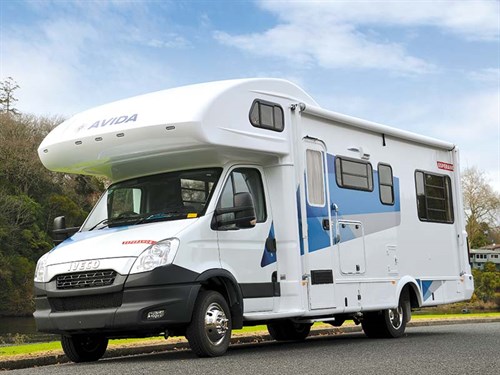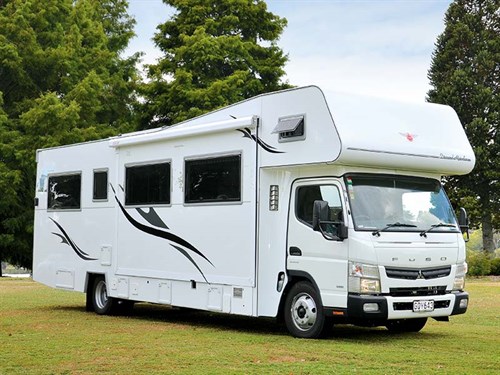
Anyone buying a new motorhome in New Zealand might not have the luxury of choosing between rear-wheel drive (RWD) and front-wheel drive (FWD) – largely because the majority of new vehicles on offer (mainly European imports) are built on a Fiat Ducato chassis – and it's FWD.
If you want a RWD vehicle, chances are you'll have to visit a local manufacturer and order a custom-built model, choosing between brands like Mercedes-Benz and Iveco for an appropriate chassis.
Fiat Ducato
That so many European builders select the Fiat Ducato for their motorhomes underscores its popularity and price competiveness. There's no denying the driveability and the stylishness of its cab – pretty impressive for what is ostensibly a 'commercial' chassis.
"It drives like a car", is a common description – and enthusiasts particularly like the six-speed automatic transmission. Auto transmissions aren't always available on a commercial chassis used for a RWD motorhome.
RWD enthusiasts will scornfully point out that there's an obvious reason the Ducato is popular in Europe: the motorhome fraternity there tends to stick to sealed roads, driving from one motorcamp to the next. Unlike their Kiwi counterparts, they rarely opt for freedom camping or venture into the bush – where unsealed roads in remote locations can trap an unwary driver.
They believe that FWD motorhomes – relative to RWD motorhomes – have comparatively poor "traction" and that in an identical wet/muddy/icy/grassy/soft terrain scenario, the FWD van is more likely to get stuck.
FWD enthusiasts will counter that if the terrain is dodgy, a RWD van is just as susceptible to wheel-spinning.
Traction and weight distribution
Good traction is largely a function of weight over the drive wheels. Most motorhomes have a large overhang at the back – an area usually filled by a bedroom, bathroom and storage lockers. It all adds up to plenty of weight – making for good traction in RWD motorhomes.
It helps that many RWD 'vans have twin wheels on the drive axle – double the footprint boosts traction considerably. But on the debit side, more weight over the rear axles might cause the wheels to sink into a soft surface more easily, raising the risk of wheel-spinning.
For FWD 'vans, that same concentration of weight at the back doesn't do any favours for traction at the front, and the problem can be accentuated when towing is brought into the equation. The additional weight of a trailer could elevate the front of the 'van, reducing traction.
Excessive weight at the rear can also affect FWD traction on steep inclines (particularly on unsealed roads), when the vehicle's weight transfers more to the rear, decreasing the tractive effort on the driving wheels.
The solution – for both types of 'vans – is better weight distribution. A sensible stowage system – with heavier items packed towards the non-drive axles – will help to distribute the weight across both axles more evenly.

Some FWD motorhome builders address the rear overhang issue by opting for a chassis with a longer wheelbase (more distance between the front and rear axles), shifting the rear axle closer to the back of the van. This certainly helps, but note that such motorhomes will have a wider turning circle and perhaps a little less manoeuvrability.
Both RWD and FWD vehicles may be equipped with traction enhancements – electronic technology that manages the drive wheels to optimise traction in wheel-slip situations. Newer-model Ducatos for example, are equipped with automatic traction control (ATC) which works in conjunction with the anti-lock braking system.
The diff-lock feature on some RWD vehicles is a similar concept– it allows the driver to lock the differential and use both sets of rear wheels to drive. In normal operation only one wheel (or set of wheels) on the rear axle provides the drive – the other runs free to cater for cornering, when the wheels rotate at different speeds.
Internal volume and headroom
A less obvious consideration in your choice between FWD and RWD is the driveshaft. On a RWD 'van, the driveshaft runs the length of the chassis – connecting the engine/gearbox to the differential on the back axle. Depending on the design of the chassis, the shaft might compromise floor height (making it higher), internal volume and headroom, and perhaps the overall height of the motorhome.
FWDs don't have a driveshaft. The engine/gearbox/drivetrain is one unit contained under the bonnet. This often results in a lower floor, more storage room in the back, more headroom and perhaps a lower overall height.
Mechanical maintenance
I concede that this may be a moot point as these days relatively few motorhome owners do their own engine maintenance, but if you're a handy type who enjoys the work you might want to look under the bonnet before committing to buying a FWD.
You'll marvel at the designer's genius in getting so much horsepower into such a small space, but you'd better have long, thin arms – ideally with multiple universal joints – if you plan to change oil and fuel filters and check belt tension yourself. By comparison, engine-servicing on a RWD is positively spacious.
Tyre wear
Every motorhome needs new tyres from time to time. New tyres for a RWD fitted with twin wheels on the back axles are more expensive (six tyres vs the FWD's four). Note that the inner tyres on a double-wheel axle are more affected by wear because of scrubbing on corners.
For me, the logical response to the FWD vs RWD debate is personal choice – there are multiple factors to consider when buying a motorhome – its drive system is only one. Furthermore, driving and parking a motorhome – irrespective of whether its FWD or RWD – should be governed by a healthy dollop of common sense.
I'm a great believer in scouting the ground – if you're nervous about the firmness of the ground, get out and walk around it to check. If in doubt, abandon the plan. If you absolutely must stop on a grassy river bank under the trees, try to park so that you're facing a slight decline to help your exit.
For the latest reviews, subscribe to Motorhomes, Caravans & Destinations magazine here.





